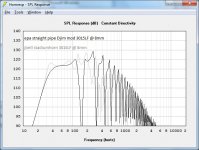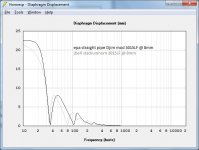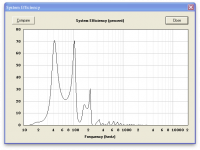You have two ways to design your TH's, both are a matter of personal choice and for each there is something to say. The most common way is to design to get the best response. That works as long you have enough headroom to play with. The other way is to design by using all info in an attempt to make an optimum balance between driver, amp power, total efficiency and the limitation of the driver (in your case that is the limiting factor).
My attempt was about a similar low end extension but with higher efficiency between the 40Hz and your crossover point. This to give you enough headroom, using full power capability from your amps (600W) and stay within limits of the driver's excursion capability. If you want more low end you run out of headroom before full power of your amps. My suggestion was to enlarge the hornmouth to 4000cm^2 in an attempt to use the front of the cab to its fullest. I checked if this suggestion was meeting power specs, excursion and still covering a similar low end. If the 4000cm^2 is presenting the actual front of the cab I don't even know, that was more a guestimate. What I do know is that a similar approach is used in the Cyclops and that it works. In stacks that gives the max acoustic coupling possible (if that will lower the low corner or not is not even important in this story, but if you use Dan's way it is possible).
My only remark about to the other suggestions is that you are overpowering your drivers (with 600W) and that they run out of headroom up higher. If the driver runs into compression mode you can't make up the losses any longer since this is a physical driver problem. Also if your highest excursion point is on the Fs of the driver it will have higher dynamic compression figures around it.
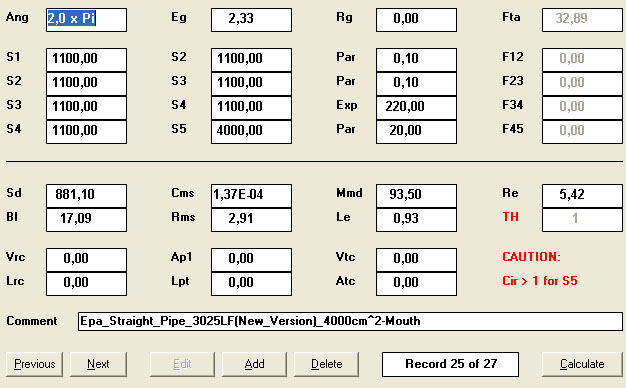
My attempt was about a similar low end extension but with higher efficiency between the 40Hz and your crossover point. This to give you enough headroom, using full power capability from your amps (600W) and stay within limits of the driver's excursion capability. If you want more low end you run out of headroom before full power of your amps. My suggestion was to enlarge the hornmouth to 4000cm^2 in an attempt to use the front of the cab to its fullest. I checked if this suggestion was meeting power specs, excursion and still covering a similar low end. If the 4000cm^2 is presenting the actual front of the cab I don't even know, that was more a guestimate. What I do know is that a similar approach is used in the Cyclops and that it works. In stacks that gives the max acoustic coupling possible (if that will lower the low corner or not is not even important in this story, but if you use Dan's way it is possible).
My only remark about to the other suggestions is that you are overpowering your drivers (with 600W) and that they run out of headroom up higher. If the driver runs into compression mode you can't make up the losses any longer since this is a physical driver problem. Also if your highest excursion point is on the Fs of the driver it will have higher dynamic compression figures around it.

Last edited:
I would prefer the optimum balance. Isn't that what life is all about? 😉
"Also if your highest excursion point is on the Fs of the driver it will have higher dynamic compression figures around it."
The closer to the Fs of the highest excursion point, the higher the dynamic compression figures around it, right? Do the higher compression figures affect all frequencies equally or do they affect frequencies up and down the passband, from that point, less? What does this say about the stadiumhorn's system?
"Also if your highest excursion point is on the Fs of the driver it will have higher dynamic compression figures around it."
The closer to the Fs of the highest excursion point, the higher the dynamic compression figures around it, right? Do the higher compression figures affect all frequencies equally or do they affect frequencies up and down the passband, from that point, less? What does this say about the stadiumhorn's system?
Attachments
updated the pic.
its verry easy to play with the mouth dimensions.(model 1 that is)
just screw the front pannel(with washers,and no glue jet)) and adjust on the fly 🙂
when your happy glue/screw it in .
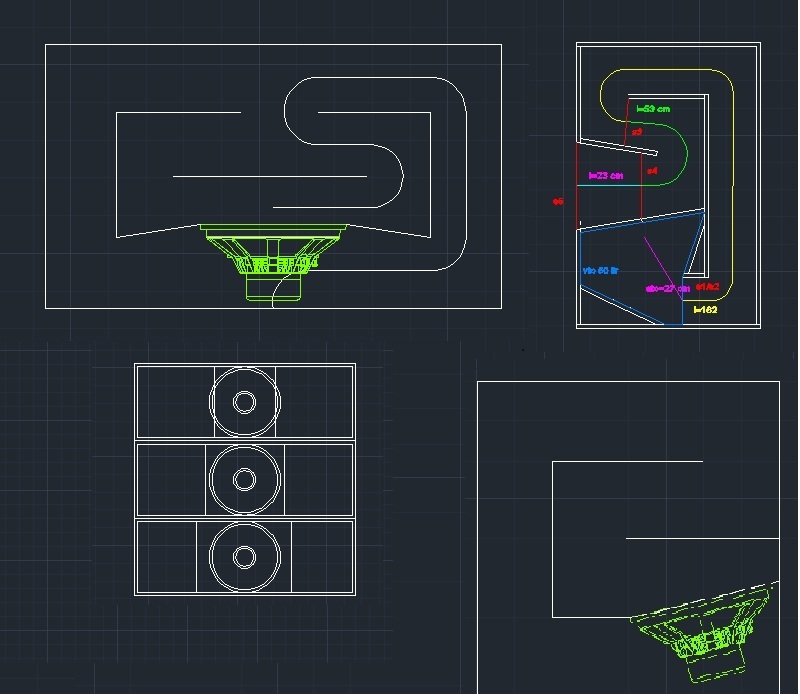
its verry easy to play with the mouth dimensions.(model 1 that is)
just screw the front pannel(with washers,and no glue jet)) and adjust on the fly 🙂
when your happy glue/screw it in .

Life isn't always complicated. A tapped horn can be simplyfied to minimal 6 straight sections of equal length, when it doesn't need to play above it's full wavelength. So, no need for fancy angled panels. The expansion from S4 to S5 can be made fully symmetric. Something like this:
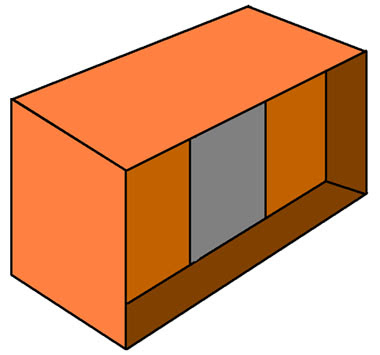
Make sure the grey opening is half size the total frontal surface and that the cavity depth is 0.6 from the diagonal of the grey opening area.
In this way you can use the cavity to put in your optional wings for the stack.

Make sure the grey opening is half size the total frontal surface and that the cavity depth is 0.6 from the diagonal of the grey opening area.
In this way you can use the cavity to put in your optional wings for the stack.
Last edited:
i dont think i understand correctly
lets say the grey area is 60x40
diagonal is 72 cm x0.6 = 43cm deep cavity?
that would be a 200 ltr cavity 😱
note,expanding area s3>s4 and s5 will have the same effect as just expanding s5(more 40>60 ,less 33 ,nicer roll off)
lets say the grey area is 60x40
diagonal is 72 cm x0.6 = 43cm deep cavity?
that would be a 200 ltr cavity 😱
note,expanding area s3>s4 and s5 will have the same effect as just expanding s5(more 40>60 ,less 33 ,nicer roll off)
To optimise the working to its fullest you have to strive to a (near) square opening (grey area). So you first calculate the opening (grey area) to set out the dimensions of the total fronti dont think i understand correctly
lets say the grey area is 60x40
diagonal is 72 cm x0.6 = 43cm deep cavity?
that would be a 200 ltr cavity 😱
note,expanding area s3>s4 and s5 will have the same effect as just expanding s5(more 40>60 ,less 33 ,nicer roll off)
But I'll use your example with a grey area of 60cm x 40cm = 2400cm^2, the total front should be twice as big = 4800cm^2.
The depth of the cavity should be calculated by the diagonal of a circle with an 2400cm^2 = 55,27cm
55,27cm x 0.6 = 33,16cm
This is the reason why I like symmetric centre openings so much. It keeps the build simple and gives the best balance. Designing this way and your stacks of two have an near equal horizontal and vertical pattern. In stacks of 4 or 8 you can use Neo Dan's trick to enlarge the system even further to make the low corner drop.
Played w/Hornresp a bit - veered from a straight pipe tho.
Is this worth it? Looks pretty good, considering the drivers' restrictions. Same LF, slightly bigger, higher sensitivity, better group delay(?), excursion peak approx same distance from Fs as Djim's mod. Sanity check, please (it's 5am here).
*Also, finished my latest dnb mix not too long ago. Figure a few of you might enjoy it on the road, exercising or just to have on your mp3 player and test your systems Here's a few diff sites to stream from (not sure what your fave is):
Here's a few diff sites to stream from (not sure what your fave is):
Soundcloud
Mixcrate
Mixcloud
To skip the bs and just download it:
Here
You're welcome to share it w/friends as I'm not sellin the mix or anything (so they can test their systems, too, of course 😉 )
Hope you're doin amazing and had a great weekend!
Is this worth it? Looks pretty good, considering the drivers' restrictions. Same LF, slightly bigger, higher sensitivity, better group delay(?), excursion peak approx same distance from Fs as Djim's mod. Sanity check, please (it's 5am here).
*Also, finished my latest dnb mix not too long ago. Figure a few of you might enjoy it on the road, exercising or just to have on your mp3 player and test your systems
 Here's a few diff sites to stream from (not sure what your fave is):
Here's a few diff sites to stream from (not sure what your fave is):Soundcloud
Mixcrate
Mixcloud
To skip the bs and just download it:
Here
You're welcome to share it w/friends as I'm not sellin the mix or anything (so they can test their systems, too, of course 😉 )
Hope you're doin amazing and had a great weekend!
Attachments
-
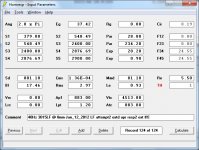 40Hz TH 3015LF ext lf attempt2, ext upper resp2, ext lf1.jpg98.5 KB · Views: 100
40Hz TH 3015LF ext lf attempt2, ext upper resp2, ext lf1.jpg98.5 KB · Views: 100 -
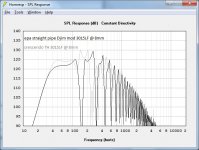 40Hz TH 3015LF ext lf attempt2, ext upper resp2, ext lf1_SPL.jpg90.2 KB · Views: 150
40Hz TH 3015LF ext lf attempt2, ext upper resp2, ext lf1_SPL.jpg90.2 KB · Views: 150 -
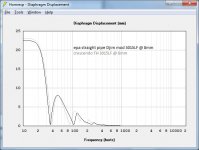 40Hz TH 3015LF ext lf attempt2, ext upper resp2, ext lf1_EXC.jpg70.3 KB · Views: 150
40Hz TH 3015LF ext lf attempt2, ext upper resp2, ext lf1_EXC.jpg70.3 KB · Views: 150 -
 40Hz TH 3015LF ext lf attempt2, ext upper resp2, ext lf1_DEL.jpg87 KB · Views: 105
40Hz TH 3015LF ext lf attempt2, ext upper resp2, ext lf1_DEL.jpg87 KB · Views: 105
Last edited:
loving it😎
lots of 30's and 40's in there.
the "problem" is in your sim you cant eq down low.
but less steeper rol off is good
your sim is 60(80~90 in reality)ltrs bigger .
get back l8rz
lots of 30's and 40's in there.
the "problem" is in your sim you cant eq down low.
but less steeper rol off is good
your sim is 60(80~90 in reality)ltrs bigger .
get back l8rz
Justin, I made you a full analyse of your mix with the Waves PAZ analyzer and nothing else, based on amplitude of the RMS signals. As you can see the 38Hz note is pretty strong throughout many of the tracks. Besides the high pitch tone (I'm still hearing) it was a fun 2 hours to listen too.
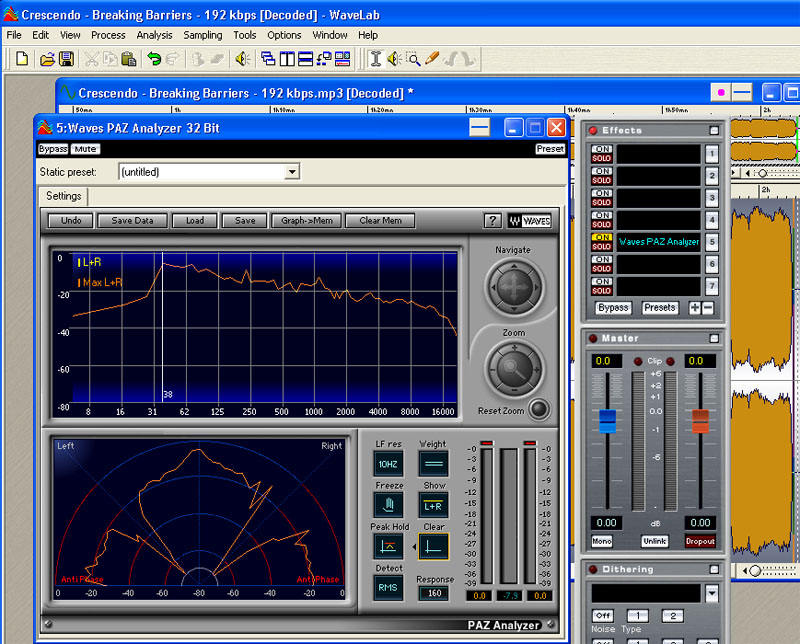

Last edited:
A second frequency rms analyse I did on your 1hour September mix. I enlarged the low frequency area to give more detail and looked like this:
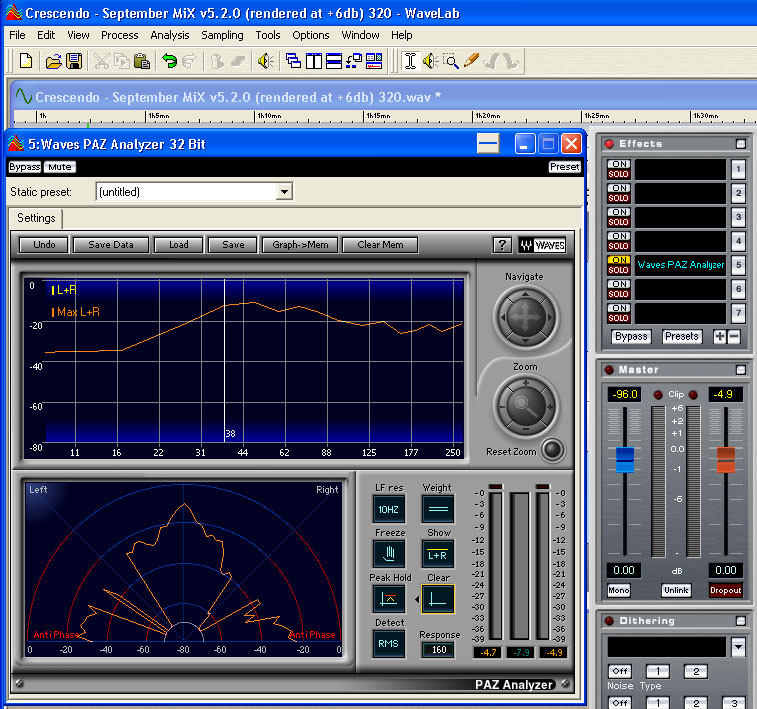
After the full mix I searched for low notes, changed the feq analyses to peak signals instead of rms. Within the mix of one hour I found true extreme low notes of 27Hz at 27:45 to 27:47 (2 seconds). Maybe I have overlooked other ones...
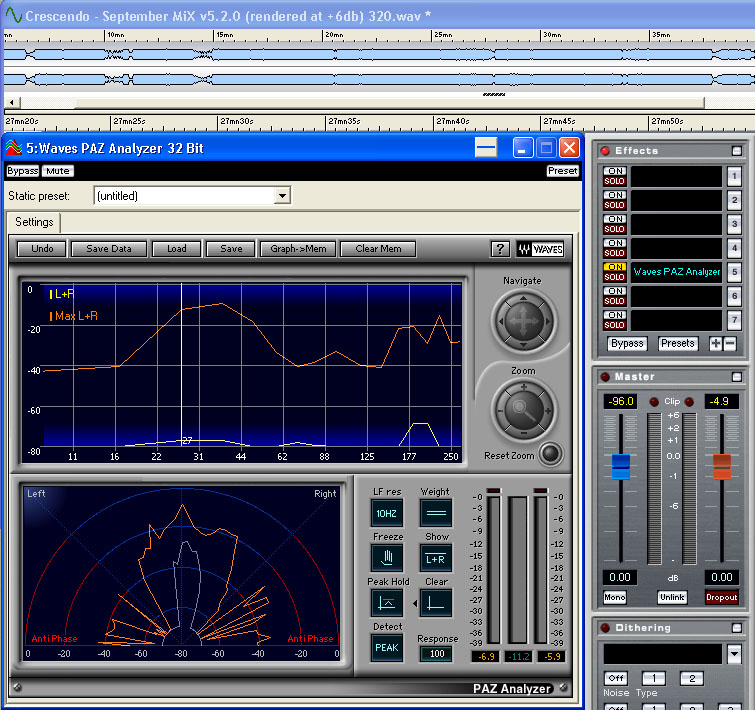

After the full mix I searched for low notes, changed the feq analyses to peak signals instead of rms. Within the mix of one hour I found true extreme low notes of 27Hz at 27:45 to 27:47 (2 seconds). Maybe I have overlooked other ones...

Thanks for those, Djim! I see you found some other mixes to listen to 🙂
I know a fewer number of tracks have the low content AND I know my mixes aren't a great representation of the absolute lowest tracks we play - but, we can see that 30z content is still quite present. And we know how much of a difference it is to us at a show when that low content rolls off early (thing dropping bass tone - and not hearing it reach full bottom).
I often think to myself at other shows, "this system just can't play those low notes." I am aiming for the system that can in fact play those low notes, with authority. If you think my model above (Post #527) will reach that goal, I trust you. If you believe it should go a bit lower, I am willing to build a bit bigger in order to reach that goal. I have another sim that extends lower just a tad more, but of course it's ~50L bigger int. (has somethin to do w/some....Iron Law... 🙄
Again, thanks for the measurements and a big thank you for sticking thru this with me. Cheers!
I know a fewer number of tracks have the low content AND I know my mixes aren't a great representation of the absolute lowest tracks we play - but, we can see that 30z content is still quite present. And we know how much of a difference it is to us at a show when that low content rolls off early (thing dropping bass tone - and not hearing it reach full bottom).
I often think to myself at other shows, "this system just can't play those low notes." I am aiming for the system that can in fact play those low notes, with authority. If you think my model above (Post #527) will reach that goal, I trust you. If you believe it should go a bit lower, I am willing to build a bit bigger in order to reach that goal. I have another sim that extends lower just a tad more, but of course it's ~50L bigger int. (has somethin to do w/some....Iron Law... 🙄
Again, thanks for the measurements and a big thank you for sticking thru this with me. Cheers!
The September mix didn’t even border my colleagues 🙂 (you can take that as a compliment). It is always fun when an open minded person is prepared to invest his time to understand before deciding what to do. I think I got a pretty good picture of your wishes/demands but as long you have to deal with the 3015’s you’ll have to accept some concessions. About the extension, it is also possible to build them as separate attachments if you like.
I also have been looking to your new suggestion of post #527. You seem to have forgotten to extend L45 so that the driver fits in the cab. By using minimal 20cm for L45 your 15”driver will fit.
If you look to what it does with the response of your TH you can see it becomes more ‘smiley’ 🙂 , though bumpier is actually a better word. When your model response becomes bumpier it will be less in reality but.... It comes with a counter reaction which doesn’t show up in HornResp. The higher these bumps in the response become, the bigger the differences in dynamic compression between the bumps and dips at maximum physical excursion. Top drivers with very stiff cones can deal with that but the 3015 will show significant compression figures in these dips. In my experience gentle roll-offs works always best and response stays closer to its predictions when the driver nears its physical max excursion.
You can use the "System Efficiency" function in HornResp, in tools, to improve your design. The higher the peaks the better the efficiency of your system. The higher the efficiency the better sensitivity figures your subs will have. Again, there is more to it. What happens when your driver gets to its maximum excursion, is that the peaks become smaller and dips lower. These ‘losses’ are dynamic compression. The more ridged the cone, the less losses. Also, the bigger the differences between the peaks and the dips, the higher the compression figures these dips will have…. Still following?
In your case the 38Hz is very important so make sure you will reach at least 5% efficiency here. Also look at the dip between the first and second peak. Try to make this dip as high as possible with minimum limit of 5%. The less difference between the efficiency peaks and the efficiency dips, the less dynamic compression differences between them. So very high efficiency peaks with very low dips is therefore a no go if you want the smoothest response at max excursion. I know, it's a lot and there is always more...
Cheers!
I also have been looking to your new suggestion of post #527. You seem to have forgotten to extend L45 so that the driver fits in the cab. By using minimal 20cm for L45 your 15”driver will fit.
If you look to what it does with the response of your TH you can see it becomes more ‘smiley’ 🙂 , though bumpier is actually a better word. When your model response becomes bumpier it will be less in reality but.... It comes with a counter reaction which doesn’t show up in HornResp. The higher these bumps in the response become, the bigger the differences in dynamic compression between the bumps and dips at maximum physical excursion. Top drivers with very stiff cones can deal with that but the 3015 will show significant compression figures in these dips. In my experience gentle roll-offs works always best and response stays closer to its predictions when the driver nears its physical max excursion.
You can use the "System Efficiency" function in HornResp, in tools, to improve your design. The higher the peaks the better the efficiency of your system. The higher the efficiency the better sensitivity figures your subs will have. Again, there is more to it. What happens when your driver gets to its maximum excursion, is that the peaks become smaller and dips lower. These ‘losses’ are dynamic compression. The more ridged the cone, the less losses. Also, the bigger the differences between the peaks and the dips, the higher the compression figures these dips will have…. Still following?

In your case the 38Hz is very important so make sure you will reach at least 5% efficiency here. Also look at the dip between the first and second peak. Try to make this dip as high as possible with minimum limit of 5%. The less difference between the efficiency peaks and the efficiency dips, the less dynamic compression differences between them. So very high efficiency peaks with very low dips is therefore a no go if you want the smoothest response at max excursion. I know, it's a lot and there is always more...
Cheers!
hiyall
to me its not those common notes i like ,but the less frequent reel deep ones(with this type of music)
anyway ,justin if you give me a sim your happy with,i wil try to sim a cab for it.
to me its not those common notes i like ,but the less frequent reel deep ones(with this type of music)
anyway ,justin if you give me a sim your happy with,i wil try to sim a cab for it.
Epa it's not a discussion about what makes this music great, it's about the driver's limitations. In my view most people design PA subs with HornResp and use the 'limitation' within HornResp to make their decisions. For Hifi that's okay since the true RMS of the signal in a living is relative low. Those few occasional full blasts, to show off to their friends of what their system is capable off, is not a problem for most drivers but that has nothing to do with PA. Especially when a PA is going to be used to play recorded dance oriented material, where the true RMS of the signal is very high and the transients are all limited and constant returning.
In your case the 38Hz is very important so make sure you will reach at least 5% efficiency here. Also look at the dip between the first and second peak. Try to make this dip as high as possible with minimum limit of 5%. The less difference between the efficiency peaks and the efficiency dips, the less dynamic compression differences between them. So very high efficiency peaks with very low dips is therefore a no go if you want the smoothest response at max excursion. I know, it's a lot and there is always more...
Cheers!
Don't forget to look at what the system does as a whole, the efficiency will add up. (not a 3015)
Attachments
Epa it's not a discussion about what makes this music great, it's about the driver's limitations. In my view most people design PA subs with HornResp and use the 'limitation' within HornResp to make their decisions. For Hifi that's okay since the true RMS of the signal in a living is relative low. Those few occasional full blasts, to show off to their friends of what their system is capable off, is not a problem for most drivers but that has nothing to do with PA. Especially when a PA is going to be used to play recorded dance oriented material, where the true RMS of the signal is very high and the transients are all limited and constant returning.
Well said.
PA and to some extent car audio subwoofers have much longer duty cycles and are subjected to much higher average power and more abuse. With home audio, or commercial theater use there are occasional very loud peaks and a few long duration sections but there is much more down time for the system to recover and lower average levels. For those apps it makes sense to model to absolute peak input values as those will be ok every once in awhile. Your speaker will not survive long or sound good operated close to that level for many hours a day several times a week.
Hi Dan,Don't forget to look at what the system does as a whole, the efficiency will add up. (not a 3015)
Thanks for pointing out but I want to get the basics across first. That’s why I ended with "it's a lot and there is always more...". But since you pointed out, I want to use the coupling for excursion control, lowering dynamic compression and response optimization rather than response extension in this specific case. He has 3 drivers per side and not 6 at this moment. Therefore I'm targeting for an equal horizontal and vertical pattern to prevent difficulties and making filtering and integration as easy as possible.
(Thanks Josh)
Last edited:
Epa it's not a discussion about what makes this music great, it's about the driver's limitations. In my view most people design PA subs with HornResp and use the 'limitation' within HornResp to make their decisions. For Hifi that's okay since the true RMS of the signal in a living is relative low. Those few occasional full blasts, to show off to their friends of what their system is capable off, is not a problem for most drivers but that has nothing to do with PA. Especially when a PA is going to be used to play recorded dance oriented material, where the true RMS of the signal is very high and the transients are all limited and constant returning.
hi djim
i was not ading to the discusion,just saying how i like it.
id rather play -6db(or more)flat to 30hz ,than listen to a loud sytem with f3 of 45 hz,imho 🙂
Hi Eric,
Sorry for the misinterpretation, although, it came in the right moment to prevent confusion what this is all about 🙂.
Sorry for the misinterpretation, although, it came in the right moment to prevent confusion what this is all about 🙂.
Last edited:
Looks like I'm using an old version of HR (28.00). No wonder I didn't see "System Efficiency". If I install the latest version (28.90) will it erase all of my records?
This is getting to be even more interesting. Thank you so much for helping me with direction. I know the language barrier can be difficult sometimes, but you're doin great and I know you mean well. So, again, thanks!
This is getting to be even more interesting. Thank you so much for helping me with direction. I know the language barrier can be difficult sometimes, but you're doin great and I know you mean well. So, again, thanks!
- Home
- Loudspeakers
- Subwoofers
- C/E/X PA Flat to 30 (FT30) PA TH Awesomeness
